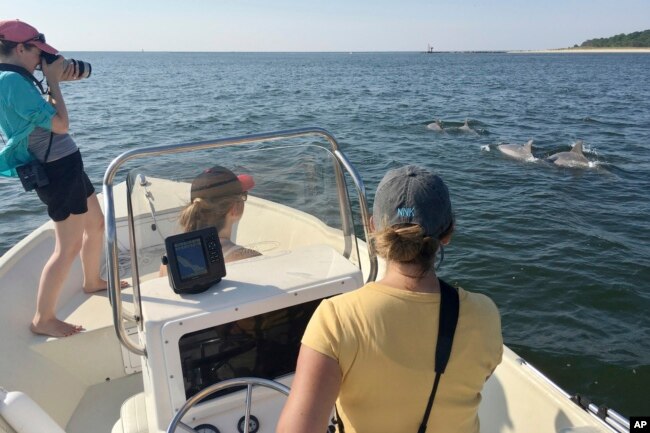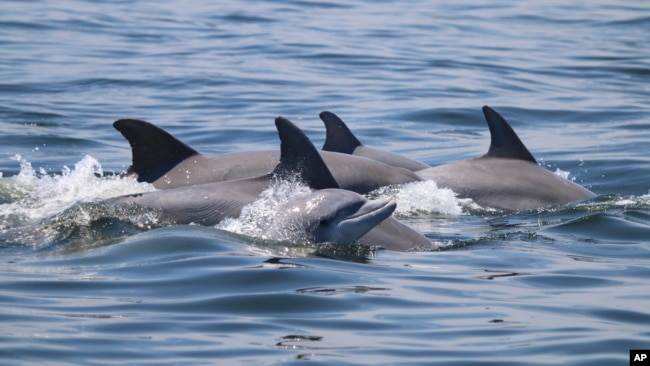イルカ社会でもウィルス蔓延
どうして人類は誕生したのでしょうか?
文明って、何でしょうか?
今、起きていることの全ては私たちがしてきたことの罪!!
苦悩を抱え日々生きる、思考が生み出す不安と期待というモンスターに翻弄されながら、”こんなもんよ”と言い訳を隠蓑にして、そして、最後の時を迎える。
どこに意味があるのでしょうか?
私はなぜ生きて・・・・そんなことを思考が申しております。
VOAで英語を学びましょう!!
イルカの社会的習性でウイルスが蔓延(和訳)
Dolphins’ Social Habits Spread Virus
April 13,2022
イルカは社会的で知的な動物です。そして、人間がハグや握手をして人間関係を維持するように、イルカは空気を吸いに水から上がるときに同時に呼吸を合わせます。この共有行為は、社会的なつながりをつくるために重要です。
しかし、同じ空気と場所を共有することは、イルカたちの間で伝染性の致命的な病気を広めることにもなるのです。
ジャネット・マン氏はワシントンDCのジョージタウン大学でイルカを研究しています。彼女や他の科学者は、このウイルスを理解しようとしています。彼らはこのウイルスをアメリカのバージニア州とメリーランド州の沖合で発見した。このウイルスは現在他の大西洋岸のイルカに広がりつつあります。
2013年から2015年にかけて、2万頭近くのイルカが死亡したウイルスの大発生がありまし。フロリダからニューヨークにかけての海岸に打ち上げられたイルカは約2,000頭。イルカの総個体数が半分になったのです。
マン氏は、イルカのウイルスは呼吸性、つまり肺の中にあり、人間のCOVIDウイルスの広がり方とよく似ていると説明しています。
「イルカが水面で一緒に呼吸するとき、私たちがお互いに話したり咳をしたりするときと同じように、呼吸器系の飛沫を共有しているのです 。」と彼女は言います。
マン氏と、ウェイクフォレスト大学医学部の動物ウイルス研究者ジェイコブ・ネグレイ氏のような他の科学者は、イルカの社会活動を追跡することによって、イルカウイルスの速い拡散を理解しています。
彼らはウイルスの生態だけでなく、弱体化したイルカの集団がどのように行動しているかを研究しているのです。
「あなたの友人は...あなたを病気にする可能性が最も高い個体でもあります。」とネグレイ氏は言います。
イルカはとても遊び好きな動物なので、人間が手をつなぐように、ヒレに触れるほど接近して泳ぐことがよくあります。また、大きな”ポッド”と呼ばれる群れで泳ぐこともよくあります。ジャネット・マンは35年にわたるイルカの研究の中で、イルカには親しい友人がいても、他のイルカのところに行ったり、ポッドから離れたりすることが多いことに気がつきました。
チェサピーク湾のイルカたちの社会生活を追跡した結果、研究者は2,000頭以上のイルカの個体識別が可能になりました。背びれにある特殊な形や模様で、イルカを識別することができるのです。
ある朝、科学者たちはポトマック川から小さなボートに乗って海へ出ました。そして、水面のすぐ近くにある黒っぽい色の物体を探しました。水面に動きがあったり、尾びれやひれが見えたりすることもあります。
研究者のうち2人が特殊なレンズを覗き、2頭のイルカを見つけました。ジョージタウン大学の生物学者メリッサ・コリアー氏と、海洋科学者のアン=マリー・ジャコビー氏です。二人はこのイルカをエイブ・リンカーンとアンドリュー・ジャクソンと名付けました。ポトマック川がワシントンD.C.を流れていることから、アメリカの大統領にちなんで名づけられたのです。
「知っているイルカを見つけるのはとてもうれしいですね。これらのオスは、過去1年間、定期的に(一緒に)目撃されています。」とジャコビー氏は語っています。
3頭目のイルカ、ジェームズ・ブキャナンは、友人のエイブとアンドリューに加わりました。3頭のイルカは水面に出てきて一緒に呼吸をしました。コリアー氏は、彼らは呼吸をするときにウイルスを共有するほど仲が良いのです、と言います。
「これは典型的な、オスの行動です。オスは互いにかなり協調しています。メスも同じですが、それほど規則的ではありません。メスはほとんど自分の子供と同期しているのです。」とマン氏は言います。
この行動パターンが、最近のウイルスの大発生でより多くのオスのイルカが死んだ理由を説明するかもしれません。研究者たちは、この考えについて引き続き研究しています。
このウイルスの発生は25年おきくらいにしばしば起こり、クジラなどイルカに似た他の動物にも影響を与えることがあります。
クリスティ・ウェスト氏は、ハワイ大学の研究者です。彼女は、「この病気は、世界中のイルカやクジラが直面している他のストレス要因と合わせると、さらに大きな脅威となります。」と述べています。
ウイルスは自然界に存在するものですが、海での人間の活動は環境や個体数をさらに弱体化させ、ウイルスを悪化させる可能性があります。炭素やプラスチックによる汚染、限られた食料源、そして気候変動による海の温暖化、これらすべてが動物に害を与えているとマン氏は言います。
ストレスはイルカの免疫システムを弱めます。「だから、イルカはウイルスの発生に対して非常に脆弱なのです。」とマン氏は言います。
科学者たちは、この研究が他のウイルスの大発生を予測するのに役立ち、人間活動が最も盛んな場所での政策を進めるのに役立つことを期待しています。つまり、ウイルスが再び発生したときに、船の交通量を減らしたり、汚染を減らしたりすることを意味しています。
Dolphins’ Social Habits Spread Virus
Dolphins are social and intelligent animals. And, like the way humans maintain relationships by hugging or giving a handshake, dolphins breathe together at the same time when they come up from the water for air. This shared act is important for creating social connections.
But sharing the same air and area is also spreading a contagious and deadly disease among the dolphins.
Janet Mann researches dolphins at Georgetown University in Washington, D.C. She and other scientists are trying to understand the virus. They discovered it in the water off the American states of Virginia and Maryland. It is now spreading to other Atlantic Coast dolphins.
There was an outbreak of the virus from 2013 to 2015 when almost 20,000 dolphins died. About 2,000 dolphins washed up on the coast from Florida to New York. The total dolphin population was cut in half.
Mann explains that the dolphin virus is respiratory, or in the lungs, much like how the COVID virus spreads in humans.
"When dolphins breathe together at the surface, they're sharing respiratory droplets just like we do when we're talking or coughing on each other," she said.
Mann and other scientists, like Jacob Negrey, an animal virus researcher from the Wake Forest School of Medicine, are understanding the fast spread of the dolphin virus by following dolphin social activities.
They study not only the biology of the virus, but how weakened dolphin populations act together.
“Your friends...are also the individuals most likely to get you sick,” Negrey said.
Since dolphins are very playful animals, they often swim so close that they touch fins, much like humans holding hands. They frequently swim in large “pods,” or groups. During her 35 years of studying dolphins, Janet Mann has noticed that even though dolphins have close friends, they visit other dolphins and leave the pod often.
Following the social lives of dolphins in the Chesapeake Bay has permitted researchers to identify over 2,000 dolphin individuals. They can remember them by their special shapes and markings on their dorsal, or back, fins.
One morning, the scientists went out to the ocean from the Potomac River in a small boat. They looked for dark, colored objects right at the surface of the water. They can often see some movement in the water or can catch a look at a tail or fin.
Two of the researchers looked through special lens and saw two dolphins. Melissa Collier is a Georgetown biologist, and Ann-Marie Jacoby is an ocean scientist. They named the dolphins Abe Lincoln and Andrew Jackson. They are named for American presidents because the Potomac River runs through Washington, D.C.
"It's so nice to find dolphins that we know. These males have been seen together regularly (together) over the past year,” said Jacoby.
A third dolphin, James Buchanan, joined his friends, Abe and Andrew. All three dolphins came to the surface of the water and breathed together. Collier said that the animals were close enough to share the virus when they breathed.
"This is typical, male behavior. The males stay pretty coordinated with each other. The females sync, but not as regularly. They sync mostly with their offspring,” Mann says.
This behavior pattern might explain why more male dolphins have died in the most recent outbreak of the virus. The researchers are continuing to study this idea.
Outbreaks of this virus often occur every 25 years or so and can affect other animals that are similar to dolphins, like whales.
Kristi West is a researcher from the University of Hawaii. She said, “The disease becomes an even more significant threat when we combine it with other stressors that dolphins and whales throughout the world are facing.”
Viruses are naturally occurring in the wild, but human activities in the ocean can make the virus worse by weakening environments and populations even more. Pollution from carbon and plastics, limited food sources, along with ocean warming from climate change, all harm the animals, Mann says.
Stressors weaken the dolphins’ immune systems. "So, they are extremely vulnerable to virus outbreaks," Mann says.
The scientists hope their research can be used to help predict when other outbreaks might happen and use the information to bring policies forward in places where human activities are highest. This could mean reducing boat traffic or pollution when the virus happens again.
Words in This Story
contagious – adj. easily able to be transferred from one to another
outbreak – n. a quick onset of disease in a portion of the population
droplets – n. drops or small amounts of liquid
fins – n. an extremity or limb of a water animal that helps them to swim
coordinated – adj. organized together
sync – v. to organize together at the same time
offspring – n. an animal’s babies or children
stressors – n. something that applies stress or strain on something else
immune systems – n. a body’s defense system to help fight illness
vulnerable – adj. weak, helpless exposed


